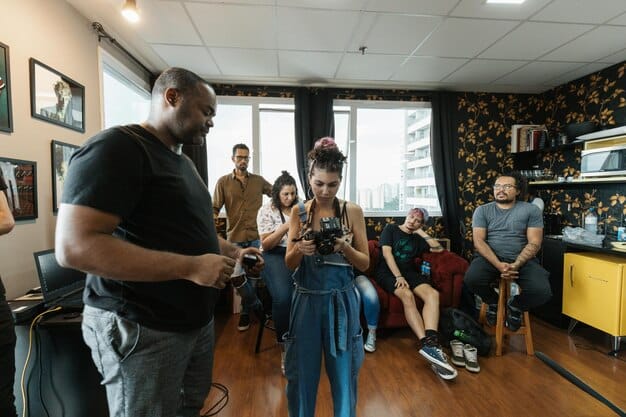Brazilian Cinema’s Representation Problem: Diversity in 2025

Brazilian cinema confronts its representation challenges with new diversity initiatives aimed at fostering more inclusive narratives and opportunities for underrepresented groups, potentially transforming the industry by 2025.
As the global spotlight increasingly falls on issues of representation, Brazilian Cinema’s Representation Problem: Are New Diversity Initiatives Making a Difference in 2025? becomes a pertinent question. This article explores the historical context of underrepresentation in Brazilian cinema and delves into current initiatives, critically assessing their potential impact on the industry’s landscape by 2025.
The Historical Roots of Underrepresentation in Brazilian Cinema
Brazilian cinema boasts a rich and complex history, marked by periods of immense creativity and political upheaval. However, mirroring many global film industries, it has long struggled with a pervasive issue of underrepresentation. Historically, narratives, characters, and behind-the-scenes roles have disproportionately favored specific demographics, primarily white, male, and often from the country’s wealthier regions. This disparity has not only limited the scope of stories told but also perpetuated stereotypes and excluded vast segments of Brazil’s diverse population from seeing themselves authentically reflected on screen.
The early days of Brazilian filmmaking were largely influenced by European styles and perspectives, which naturally carried over biases into casting and storytelling. As cinema evolved, financial constraints and power structures often meant that access to film production remained concentrated, further entrenching these patterns. This created a cycle where established voices continued to dominate, making it exceptionally difficult for new, diverse voices to emerge and challenge the status quo.
The Whitewashing of Brazilian Narratives
One of the most striking aspects of this historical underrepresentation is the prevalence of whitewashing. Despite Brazil being a nation where the majority identifies as Black or Pardo (brown), the portrayal of its people in cinema has often skewed towards lighter skin tones. This phenomenon extends beyond on-screen presence, permeating directorial, production, and writing roles. The consequence is a cinematic landscape that frequently fails to capture the true essence of Brazilian culture and its people’s lived experiences.
- Limited Character Depth: Non-white characters often relegated to minor roles or stereotypes.
- Narrative Erasure: Stories from marginalized communities rarely reach mainstream platforms.
- Lack of Authentic Voices: Directors and writers from diverse backgrounds face barriers to entry.
The impact of this historical bias is profound, shaping public perception and contributing to a narrow understanding of what constitutes “Brazilian identity” on an international stage. Efforts to diversify must therefore contend with decades of deeply ingrained practices and artistic conventions that have, perhaps unintentionally, reinforced these exclusionary patterns.
Understanding the Current Landscape: Challenges and Opportunities
The journey towards a more representative Brazilian cinema is fraught with challenges, yet it is also brimming with unprecedented opportunities. Recognizing the historical imbalances is merely the first step; confronting the systemic issues that perpetuate them requires sustained effort and a multi-faceted approach. The current landscape is characterized by a growing awareness of these issues, particularly from younger generations of filmmakers and audiences who demand more authentic and inclusive storytelling.
One of the primary challenges remains funding. Independent and diverse productions often struggle to secure the necessary financial backing, as traditional investors tend to favor projects with perceived lower risk, often those conforming to established industry norms. This financial hurdle disproportionately affects filmmakers from marginalized communities who may lack the established networks and resources. Moreover, the distribution and exhibition infrastructure still heavily favors mainstream productions, making it difficult for diverse films to reach a broader audience, even when they do get made.
Digital Platforms and Accessibility
However, the advent of digital streaming platforms has emerged as a significant opportunity. These platforms, with their global reach and demand for diverse content, offer new avenues for Brazilian filmmakers to bypass traditional gatekeepers. They have democratized access to production and distribution, allowing for a wider array of voices to be heard. This shift also enables audiences to discover films that might otherwise never have been shown in traditional cinemas, fostering a thirst for more varied narratives.
- Wider Reach: Streaming services expose Brazilian films to global audiences.
- Reduced Barriers: Easier for independent filmmakers to distribute their work.
- New Funding Models: Potential for diverse investors and financing structures through digital avenues.
The conversation around representation is also becoming more mainstream within Brazil. Public discourse, fueled by social media and cultural movements, is putting pressure on the industry to evolve. Film festivals, educational institutions, and cultural bodies are increasingly prioritizing diversity, establishing workshops, mentorship programs, and dedicated funding calls for underrepresented groups. These initiatives, while still nascent, represent a crucial shift in the industry’s internal dynamics.

Key Diversity Initiatives Shaping Brazilian Cinema in 2025
In response to growing demands for change and a recognition of historical inequities, several pivotal diversity initiatives have emerged within Brazilian cinema. These efforts are multifaceted, encompassing policy changes, funding mechanisms, educational programs, and advocacy from within the industry. Their combined aim is to dismantle systemic barriers and foster environments where diverse voices can thrive, significantly influencing the landscape by 2025.
ANCINE, Brazil’s National Film Agency, has been instrumental in implementing some of these changes. Through various programs and regulations, they have sought to promote greater inclusion, particularly in terms of racial and gender representation. This includes setting quotas for federal funding to be allocated to projects led by and featuring underrepresented groups. The shift from voluntary guidelines to mandatory quotas marks a significant step towards tangible change, compelling production companies to actively seek out diverse talent.
Public Funding and Quotas for Inclusion
One of the most impactful initiatives involves the redirection of public funds towards projects that meet diversity criteria. This ensures that financial support, a critical lifeline for film production, is deliberately channeled to correct historical imbalances. These quotas are not merely about ticking boxes; they are designed to stimulate the creation of narratives that resonate with a broader spectrum of the Brazilian population and reflect the nation’s true demographic composition.
- Mandatory Funding Allocations: A percentage of federal funds reserved for diverse projects.
- Incentives for Inclusive Casting: Programs encouraging broader representation on screen.
- Support for First-Time Directors: Focus on new talent from underrepresented backgrounds.
Beyond federal initiatives, many independent organizations and festivals are also playing a crucial role. Film festivals across Brazil are increasingly featuring dedicated sections for films by Black and Indigenous filmmakers, LGBTQIA+ narratives, and women directors. These platforms not only showcase diverse talent but also provide networking opportunities and a sense of community for artists who have historically felt marginalized. Education and mentorship programs are also on the rise, aiming to equip a new generation of filmmakers with the skills and connections needed to succeed.
Beyond Numbers: Evaluating the Depth of Representation
While the implementation of diversity quotas and initiatives aimed at increasing representation numbers is a crucial first step, the true measure of their success lies in the depth and authenticity of the representation achieved. It’s not enough to merely see more diverse faces on screen or more diverse names in the credits. The critical question for 2025 is whether these initiatives are fostering genuine, nuanced, and stereotype-breaking portrayals that truly reflect Brazil’s rich tapestry of cultures and identities.
Superficial inclusion, often referred to as “tokenism,” can sometimes be an unintended consequence of diversity mandates. This occurs when diverse characters or crew members are included primarily to meet a quota, without a genuine commitment to exploring their lived experiences or giving them meaningful agency within the narrative. Such practices can inadvertently perpetuate stereotypes or fail to challenge the underlying biases that led to underrepresentation in the first place.
Authenticity in Storytelling
For representation to be truly impactful, it must spring from authentic voices. This means empowering filmmakers, writers, and artists from underrepresented communities to tell their own stories, from their own perspectives, without external filters or pressures to conform to established norms. When creators have agency over their narratives, the resulting work is often richer, more complex, and resonates more deeply with audiences who share similar lived experiences.
- Empowering Diverse Storytellers: Providing platforms for marginalized voices.
- Nuanced Character Development: Moving beyond stereotypical portrayals.
- Challenging Gaze: Shifting the perspective from an “othering” view to an internal one.
The dialogue around representation in 2025 must therefore evolve beyond mere statistics. It needs to delve into the qualitative aspects: Are these new narratives challenging existing power structures? Are they creating new archetypes? Are they fostering empathy and understanding across different social groups? The aim should be to create a cinematic ecosystem where diverse stories are not just present, but cherished and critically engaged with, contributing meaningfully to the national and global cultural discourse.
Impact on Production, Distribution, and Audience Reception by 2025
The diversity initiatives currently underway are poised to significantly reshape a range of aspects within Brazilian cinema by 2025, from the initial stages of production to how films are distributed and ultimately received by audiences. These changes are not isolated to individual projects but are beginning to influence the entire ecosystem of Brazilian filmmaking, creating a palpable shift in industry norms and expectations.
In terms of production, the increased focus on diversity is leading to more varied crews and artistic teams. Directors are actively seeking out writers, cinematographers, and other key personnel from underrepresented groups, recognizing that diverse perspectives behind the camera lead to richer storytelling on screen. This is also contributing to a more inclusive working environment, challenging long-standing hierarchies and opening up opportunities for talent that might otherwise have been overlooked. The ripple effect extends to casting, with more casting directors specifically looking for actors who authentically represent the diverse demographics of Brazil, breaking free from traditional beauty standards and casting tropes.
Evolving Distribution Channels
Distribution is another area undergoing significant transformation. While traditional theatrical releases still hold cultural prestige, the growing dominance of streaming platforms has provided an unprecedented avenue for diverse Brazilian films to reach both national and international audiences. These platforms are often more willing to take risks on non-traditional narratives and niche audiences, which benefits films that might not fit the conventional multiplex mold. By 2025, we can expect a robust pipeline of diverse content directly accessible to viewers worldwide, diversifying the global perception of Brazilian cinema.
- Strategic Streaming Partnerships: Brazilian films securing global streaming deals.
- Niche Audience Development: Successfully reaching specific cultural groups.
- Accessible Independent Film Circuit: Greater visibility for films from smaller production houses.
Audience reception is perhaps the most critical indicator of success. As more diverse stories are told, audiences themselves are evolving. There’s a growing appetite for stories that reflect their own realities, experiences, and cultural backgrounds. This leads to stronger engagement and a more dynamic relationship between filmmakers and their viewers. By 2025, a more diverse cinematic output will likely cultivate a broader and more engaged audience base within Brazil, challenging the notion that only certain types of stories can achieve commercial success. International audiences, too, are becoming more attuned to the nuances of global cinema, fostering a greater appreciation for Brazilian films that offer authentic and varied perspectives.
Case Studies and Emerging Success Stories
To truly understand the tangible impact of diversity initiatives in Brazilian cinema, it’s essential to look at concrete examples and emerging success stories. While systemic change is gradual, several films and productions are already paving the way, demonstrating that authentic representation is not only possible but also resonates deeply with audiences and critics alike. These case studies highlight efforts across different facets of the industry, from independent productions making waves internationally to mainstream films embracing greater inclusivity.
One notable example is the increasing visibility of Afro-Brazilian narratives and talent. Films like “Bacurau” (2019), while not solely a diversity initiative product, showcased a powerful and diverse ensemble, drawing critical acclaim globally and sparking conversations about representation. More recently, productions consciously prioritize casting Black actors in leading roles that defy stereotypes, and providing opportunities for Black directors and writers. This shift is crucial, given that Afro-Brazilians constitute the majority of the population, yet have historically been marginalized on screen.
Breaking Barriers for Indigenous Voices
Another significant area of growth is the amplification of Indigenous voices. For decades, Indigenous communities were either absent from Brazilian cinema or depicted through stereotypes. Now, there’s a concerted effort to support Indigenous filmmakers telling their own stories. Documentaries and fictional films created by Indigenous artists are gaining traction, offering vital perspectives on culture, land rights, and contemporary challenges. These films are not just about representation; they are acts of cultural preservation and political assertion.
- Indigenous-Led Productions: Films created and directed by Indigenous individuals.
- Celebration of Regional Cultures: Highlighting diverse cultural nuances from across Brazil.
- LGBTQIA+ Narratives: Increased visibility and complex portrayals of queer lives.
Furthermore, the landscape for LGBTQIA+ representation is also expanding. While challenges remain, there’s a growing body of work that explores queer identities with complexity and authenticity, moving beyond simplistic or tragic narratives. These films are finding audiences in both arthouse circuits and, increasingly, on streaming platforms, demonstrating a clear demand for these stories. The success of these diverse projects serves as powerful evidence that investing in and promoting varied voices can lead to artistic excellence and critical recognition, ultimately enriching Brazilian cinema as a whole.
The Road Ahead: Sustaining Momentum and Long-Term Vision for 2025 and Beyond
While significant progress has been made in addressing Brazilian cinema’s representation problem, the road ahead requires sustained momentum and a clear long-term vision for 2025 and beyond. The current initiatives are vital, but their ultimate success hinges on their institutionalization and continued evolution, ensuring that diversity becomes an intrinsic part of the industry rather than a temporary trend. This demands a commitment that extends beyond mere compliance with quotas, embracing a holistic approach to inclusion.
One of the biggest challenges will be maintaining political and financial support for these initiatives, particularly in times of economic shifts or political instability. Public funding has been a cornerstone of many diversity programs, and ensuring its stability and continued allocation to inclusive projects is paramount. Advocacy groups and industry professionals must remain vigilant, lobbying for policies that safeguard and enhance these gains, preventing any backsliding on the progress made.
Fostering a Culture of Inclusion
Beyond policy and funding, building a truly inclusive culture within the Brazilian film industry is crucial. This involves fostering environments where diverse talents feel safe, respected, and empowered to contribute their unique perspectives. It means challenging unconscious biases in hiring practices, promoting mentorship, and creating networks that support and elevate underrepresented professionals at every level, from film school students to established producers.
- Mentorship Programs: Connecting new talent with experienced professionals.
- Bias Training: Educating industry leaders on implicit biases.
- Community Building: Creating supportive networks for diverse filmmakers.
The long-term vision for Brazilian cinema in 2025 and beyond must prioritize a dynamic, evolving understanding of diversity that reflects Brazil’s complex and changing society. This includes not only racial and gender representation but also geographical diversity, socio-economic background, physical abilities, and varied sexual orientations. A truly representative cinema will tell stories from all corners of Brazil, reflecting its myriad cultures, languages, and regional identities. The goal is to move towards an industry where diversity is not an add-on or an obligation, but a fundamental driver of creativity, innovation, and global relevance, enriching both art and society.
| Key Point | Brief Description |
|---|---|
| 🎬 Historical Bias | Brazilian cinema historically favored white, male perspectives, underrepresenting diverse identities. |
| 💸 New Initiatives | Public funding quotas and policy changes are driving increased diversity in production and roles. |
| 🌟 Authentic Storytelling | Focus shifting from mere numbers to genuinely nuanced and stereotype-breaking portrayals. |
| 🚀 Future Outlook | Sustaining momentum and fostering deeper cultural inclusion define the long-term vision beyond 2025. |
Frequently Asked Questions About Diversity in Brazilian Cinema
▼
Brazilian cinema has historically suffered from a lack of diverse representation, predominantly featuring white, male characters and perspectives. This has led to the underrepresentation of Afro-Brazilians, Indigenous peoples, women, and LGBTQIA+ individuals, both on screen and behind the scenes, failing to reflect Brazil’s rich demographic diversity.
▼
By 2025, new initiatives, including federal funding quotas and inclusive policies by organizations like ANCINE, are significantly increasing diverse representation. These efforts are leading to more varied content, greater opportunities for underrepresented filmmakers, and a push for more authentic and nuanced portrayals of Brazilian society across gender, race, and sexuality.
▼
Streaming platforms like Netflix and Amazon Prime are crucial for promoting diversity in Brazilian cinema. They offer new distribution channels that bypass traditional gatekeepers, allowing for a wider array of independent and diverse films to reach global audiences. This expanded reach helps democratize access and encourages investment in previously marginalized narratives.
▼
While quantitative measures (like quotas) are important, the focus is increasingly shifting towards the depth and authenticity of representation. The goal is to move beyond mere tokenism to foster narratives that genuinely explore diverse experiences, challenge stereotypes, and empower creators from underrepresented communities to tell their own complex stories with nuance and integrity.
▼
Beyond 2025, the long-term vision is to institutionalize diversity as a core value of the Brazilian film industry. This includes robust, sustained funding, ongoing professional development for diverse talent, and the creation of a truly inclusive cultural environment. The aim is for Brazilian cinema to fully reflect the country’s rich tapestry of identities and cultures, driving both artistic excellence and global relevance.
Conclusion
The journey for Brazilian cinema towards authentic and comprehensive representation is an ongoing endeavor, marked by both historical challenges and promising new initiatives. By 2025, the impact of these concerted efforts is visibly shaping the industry, fostering a more inclusive environment that better reflects Brazil’s complex and vibrant society. While challenges remain, the commitment to diversity is not merely a trend but a fundamental shift towards a richer, more relevant cinematic future.





